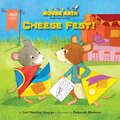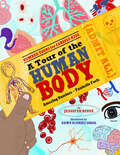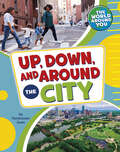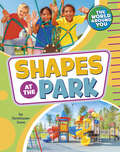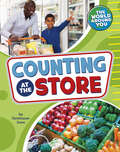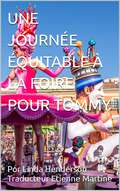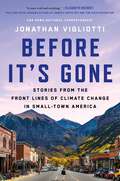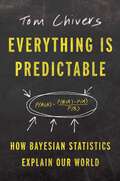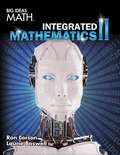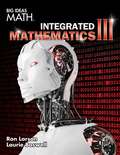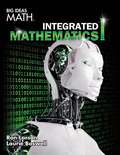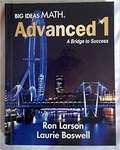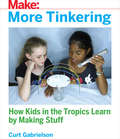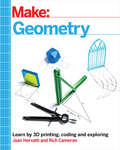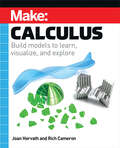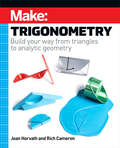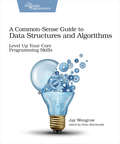- Table View
- List View
Mysterious Patterns: Finding Fractals in Nature
by Sarah C. CampbellNature's repeating patterns, better known as fractals, are beautiful, universal, and explain much about how things grow. Fractals can also be quantified mathematically. Here is an elegant introduction to fractals through examples that can be seen in parks, rivers, and our very own backyards. Young readers will be fascinated to learn that broccoli florets are fractals—just like mountain ranges, river systems, and trees—and will share in the wonder of math as it is reflected in the world around us. Perfect for any elementary school classroom or library, Mysterious Patterns is an exciting interdisciplinary introduction to repeating patterns.
Cheese Fest!: Composing Shapes (Mouse Math)
by Lori Haskins HouranEach read-aloud book in the Mouse Math series focuses on a single, basic math concept and features adorable mice, Albert and Wanda, who live in a People House. Entertaining fiction stories capture kids&’ imaginations as the mice learn about numbers, shapes, sizes and more. Over 3 million copies sold worldwide!Cheese Fest! It&’s every mouse&’s most magical time of the year. This year, Albert and Wanda will even have a booth at the fair . . . once they build it. Albert&’s plans are big, but the cardboard supply is small. How can he make the Cheese Fest booth of his dreams when all he has are a bunch of triangles? Every Mouse Math title focuses on a single basic math concept and includes back matter activities that support and extend reading comprehension and math skills, plus free online activities. (Math concept: Shapes.)
A Tour of the Human Body: Amazing Numbers--Fantastic Facts (Number Tours for Curious Kids)
by Jennifer BerneJennifer Berne takes children on a tour of the human body to reveal the wonders of how it works -- with some astonishing numbers and fascinating facts along the way.From our eyes to our toes, kids will find out what makes the human body tick. They&’ll discover that our hearts beat 100,000 times a day, which equals 36 MILLION times a year. And that our tongue&’s 8,000 taste buds can detect only 5 flavors. And that we have 60,000 miles of blood vessels, enough to circle the world more than twice!With such remarkable facts and numbers, and vivid informative illustrations by Dawn DeVries Sokol, this book takes your child on an entertainingly educational journey through the wonders of the human body.
Up, Down, and Around the City (The World Around You)
by Christianne JonesZoom! The elevator zips from the bottom floor to the top floor of a tall building. Beep! Beep! The subway stops for people to get on and off. Using bright photographs and interactive, rhyming text, this picture book will help young readers discover position words while exploring the city.
Shapes at the Park (The World Around You)
by Christianne JonesFrom rectangular ladders to circular rings and hexagonal picnic tables, the park is full of shapes! Finding shapes adds even more fun to a day at the park, and early learners will be fully engaged with the interactive, rhyming text and colorful photos in this picture book.
Counting at the Store (The World Around You)
by Christianne JonesPiles of tart apples. Cans of delicious soup. Rows of crunchy carrots. The grocery store is full of tasty foods and other items to count. The interactive, rhyming text and colorful photographs will have young learners counting along with every page in this picture book.
Une journée équitable à la foire pour Tommy
by Linda HendersonLa foire promet des expériences intéressantes pour les jeunes et les moins jeunes. Tommy aime particulièrement les manèges et les animaux de la foire. Il aimait aussi faire des additions dans sa tête. C'est ainsi qu'il a découvert qu'il y avait beaucoup de choses à additionner à la foire. Alors qu'il écoutait son oncle Albert calculer le prix des tickets d'entrée, celui-ci lui a donné une leçon de vie sur l'importance de traiter les gens de manière juste et équitable. Nous pouvons tous tirer des leçons de ce que l'oncle Albert a dit à Tommy. Dans ce livre facile à lire pour les 6-8 ans, les enfants peuvent s'amuser avec Tommy et sa famille pendant qu'ils parcourent le champ de foire. Ils peuvent exercer leur esprit en pratiquant les mathématiques. Et à la fin du livre, les enfants découvrent celui qui nous considère tous comme des êtres égaux !
Before It's Gone: Stories from the Front Lines of Climate Change in Small-Town America
by Jonathan VigliottiFrom CBS News national correspondent Jonathan Vigliotti, a &“vivid&” (Elizabeth Kolbert, Pulitzer Prize–winning author) and &“stunning&” (Booklist) character-driven call to action on our climate, told through the stories of the pioneering Americans working to persevere as leadership inaction risks the very survival of our heartland and hometowns.Discussion of the climate crisis has always suffered from a problem of abstraction. Data points and warnings of an overheated future struggle to break through the noise of everyday life. Deniers often portray climate solutions as inconvenient, expensive, and unnecessary. And many politicians, cloistered by status and focused always on their next election, do not yet see climate as a winning issue in the short run, so they don&’t take any action at all. But climate change, and its devastating consequences, has kept apace whether we want to pay attention or not. CBS News national correspondent Jonathan Vigliotti has seen that crisis unfold for himself, spending nearly two decades reporting across the United States (and the world) documenting the people, communities, landmarks, and traditions we&’ve already surrendered. Vigliotti shares with urgency and personal touch the story of an America on the brink. Before It&’s Gone traces Vigliotti&’s travels across the country, taking him to the frontlines of climate disaster and revealing the genuine impacts of climate change that countless Americans have already been forced to confront. From massive forest fires in California to hurricanes in Louisiana, receding coastlines in Massachusetts and devastated fisheries in Alaska, we learn that warnings of a future impacted by climate are no more; the climate catastrophe is already here. This is the story of America, and Americans, on the edge, and a powerful argument that radical action on climate change with a respect for its people and traditions is not only possible, but also the only way to preserve what we love.
Everything Is Predictable: How Bayesian Statistics Explain Our World
by Tom ChiversA captivating and user-friendly tour of Bayes&’s theorem and its global impact on modern life from the acclaimed science writer and author of The Rationalist&’s Guide to the Galaxy.At its simplest, Bayes&’s theorem describes the probability of an event, based on prior knowledge of conditions that might be related to the event. But in Everything Is Predictable, Tom Chivers lays out how it affects every aspect of our lives. He explains why highly accurate screening tests can lead to false positives and how a failure to account for it in court has put innocent people in jail. A cornerstone of rational thought, many argue that Bayes&’s theorem is a description of almost everything. But who was the man who lent his name to this theorem? How did an 18th-century Presbyterian minister and amateur mathematician uncover a theorem that would affect fields as diverse as medicine, law, and artificial intelligence? Fusing biography, razor-sharp science writing, and intellectual history, Everything Is Predictable is an entertaining tour of Bayes&’s theorem and its impact on modern life, showing how a single compelling idea can have far reaching consequences.
Big Ideas Math, Course 1, A Bridge to Success: A Bridge To Success
by Ron Larson Laurie BoswellNIMAC-sourced textbook
Big Ideas Math, Advanced 1: A Bridge to Success
by Ron Larson Laurie BoswellNIMAC-sourced textbook <P><P>The Big Ideas Math: A Bridge to Success Student Edition features several components to help position students for success, and keep them on the right track for mathematical proficiency. The Big Ideas Math Student Edition provides students with diverse opportunities to develop problem-solving and communication skills through deductive reasoning and exploration. Students gain a deeper understanding of math concepts by narrowing their focus to fewer topics at each grade level. Students master content through inductive reasoning opportunities, engaging activites that provide deeper understanding, concise, stepped-out examples, rich, thought-provoking exercises, and a continual building on what has previously been taught.
Big Ideas Math Green: A Common Core Curriculum
by Ron LarsonBIG IDEAS MATH® Green Common Core Curriculum Ron Larson Laurie Boswell
Big Ideas Math MS Blue: A Common Core Curriculum, Student Edition
by Ron LarsonThe revised Big Ideas Math series uses the same research-based strategy of a balanced approach to instruction that made the first Big Ideas Math series so successful. This approach opens doors to abstract thought, reasoning, and inquiry as students persevere to answer the Essential Questions that introduce each section. The foundation of the program is the Common Core Standards for Mathematical Content and Standards for Mathematical Practice. Students are subtly introduced to "Habits of Mind" that help them internalize concepts for a greater depth of understanding. These habits serve students well not only in mathematics, but across all curricula throughout their academic careers. The Big Ideas Math series exposes students to highly motivating and relevant problems. Woven throughout the series are the depth and rigor students need to prepare for career-readiness and other college-level courses. In addition, the Big Ideas Math series prepares students to meet the challenge of PARCC and Smarter Balanced testing.
Big Ideas Math Advanced 2: A Bridge to Success, Student Edition
by Ron Larson Laurie BoswellBig Ideas Math Ms Advanced 2: A Bridge To Success, Student Edition
More Tinkering: How Kids in the Tropics Learn by Making Stuff
by Curt GabrielsonTinkering is a way of learning through hands-on activity -- experimenting with materials and devices to see how they work, taking things apart, making small changes and improvements, exploring and inventing. Tinkering may seem like a form of play -- and it is -- but it is also a powerful way of discovering truths about science, engineering, and math. With this book, Curt Gabrielson follows up on his best-seller Tinkering: Kids Learn by Making Stuff with this all-new volume that features more than three dozen fun and educational tinkering projects based on his years of working with kids in the tropical island nation of Timor-Leste. Step-by-step instructions accompanied by full-color photos take you through a range of enjoyable projects that explore life sciences, physics, chemistry, earth sciences, and mathematics. You'll discover how math is used to make baskets, how fungi create fermentation, how electricity can make a magnet, how the greenhouse effect creates warming, and much more. The author also enlivens his latest batch of tinkering projects with colorful tales of his experiences in the tropic and the lives of the people he' s met there.Inside you'll find:Clear directions for making simple projects and doing activities that teach science, mathematics and engineeringProjects rooted in day to day life and experience in a small, developing nation in the Asian tropicsFull-color photographs throughoutExplicit connections to standard STEAM concepts, K-12Activities doable with less than $5 worth of common materialsThis book is perfect for parents, teachers, and students with an interest in hands-on, tinkering-based science and mathematics education, whether in traditional schools or in home-schooling situations. It will also be of interest to anyone who wants to learn more about developing nations, the culture and unique history of Timor-Leste, tropical nations or Asian cultures, with specific links to Indonesia, Portugal, or Australia.
Make: Geometry
by Joan Horvath Rich CameronGeometry, of all the branches of mathematics, is the one that is most easily visualized by making something. However, it is all too easy to reduce it to reams of formulas to memorize and proofs to replicate. This book aims to take geometry back to its practical roots with 3D printed models and puzzles as well as demonstrations with household objects like flashlights and paper towel tubes.This is not a traditional geometry textbook, but rather builds up understanding of geometry concepts while also bringing in elements of concepts normally learned much later. Some of the models are counterintuitive, and figuring out how and why they work will both entertain and give insights. Two final chapters suggesting open-ended projects in astronomy and physics, and art and architecture, allow for deeper understanding and integration of the learning in the rest of the book.
Make: Calculus
by Joan Horvath Rich CameronWhen Isaac Newton developed calculus in the 1600s, he was trying to tie together math and physics in an intuitive, geometrical way. But over time math and physics teaching became heavily weighted toward algebra, and less toward geometrical problem solving. However, many practicing mathematicians and physicists will get their intuition geometrically first and do the algebra later. Make:Calculus imagines how Newton might have used 3D printed models, construction toys, programming, craft materials, and an Arduino or two to teach calculus concepts in an intuitive way. The book uses as little reliance on algebra as possible while still retaining enough to allow comparison with a traditional curriculum. This book is not a traditional Calculus I textbook. Rather, it will take the reader on a tour of key concepts in calculus that lend themselves to hands-on projects. This book also defines terms and common symbols for them so that self-learners can learn more on their own.
Make: Trigonometry
by Joan Horvath Rich CameronTrigonometry has 2000-year-old roots in everyday useful endeavors, like finding the size of an object too big or far away to measure directly, or navigating from Point A to Point B. However, it is often taught very theoretically, with an emphasis on abstractions. Make: Trigonometry uses 3D printable models and readily-available physical objects like wire and cardboard tubes to develop intuition about concepts in trigonometry and basic analytic geometry. Readers will imagine the thought process of the people who invented these mathematical concepts, and can try out "math experiments" to see for themselves how ingenious ancient navigators and surveyors really were.The analytic geometry part of the book links equations to many of these intuitive concepts, which we explore through in-depth explanations of manipulative models of conic sections. This book is aimed at high school students who might be in Algebra II or Pre-Calculus. It shows the geometrical and practical sides of these topics that otherwise can drown in their own algebra.Make: Trigonometry builds on the basics of the authors' earlier book, Make: Geometry, and is intended as a bridge from that book to their Make: Calculus book. The user can read this book and understand the concepts from the photographs of 3D printable models alone. However, since many models are puzzle-like, we encourage the reader to print the models on any consumer-grade filament based 3D printer. The models are available for download in a freely-available open source repository. They were created in the free program OpenSCAD, and can be 3D printed or modified by the student in OpenSCAD to learn a little coding along the way.
A Common-Sense Guide to Data Structures and Algorithms: Level Up Your Core Programming Skills
by Jay Wengrow"Algorithms and data structures are much more than abstract concepts. Mastering them enables you to write code that runs faster and more efficiently, which is particularly important for today’s web and mobile apps. This book takes a practical approach to data structures and algorithms, with techniques and real-world scenarios that you can use in your daily production code. Graphics and examples make these computer science concepts understandable and relevant. You can use these techniques with any language; examples in the book are in JavaScript, Python, and Ruby.Use Big O notation, the primary tool for evaluating algorithms, to measure and articulate the efficiency of your code, and modify your algorithm to make it faster. Find out how your choice of arrays, linked lists, and hash tables can dramatically affect the code you write. Use recursion to solve tricky problems and create algorithms that run exponentially faster than the alternatives. Dig into advanced data structures such as binary trees and graphs to help scale specialized applications such as social networks and mapping software. You’ll even encounter a single keyword that can give your code a turbo boost. Jay Wengrow brings to this book the key teaching practices he developed as a web development bootcamp founder and educator.Use these techniques today to make your code faster and more scalable."

